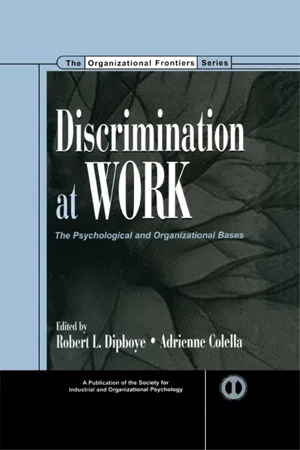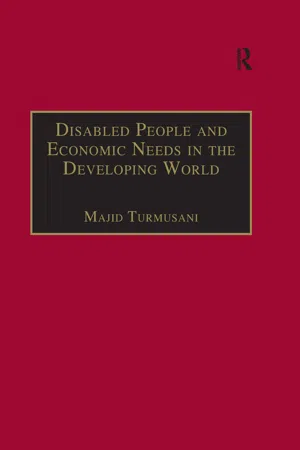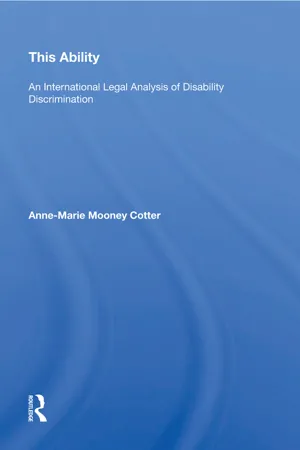Social Sciences
Disability Discrimination
Disability discrimination refers to the unfair treatment of individuals based on their physical or mental impairments. This can manifest in various forms, such as exclusion from opportunities, unequal access to resources, or negative attitudes and stereotypes. It is a violation of human rights and can have significant social, economic, and psychological impacts on those affected.
Written by Perlego with AI-assistance
Related key terms
6 Key excerpts on "Disability Discrimination"
- Errol P. Mendes, Sakunthala Srighanthan(Authors)
- 2009(Publication Date)
- University of Ottawa Press(Publisher)
Educational discrimination refers mainly to the refusal to allow disabled persons to go to school or the imposition of addition conditions on disabled persons in the management of school affairs, thereby resulting in the restriction or obstruction of the exercise of the right to education by disabled persons. A common discrimination against disability, employment discrimination is usually seen in the refusal to employ disabled persons or unfair treatment to such persons in training, promotion, salary and remuneration, and work conditions. Cultural and sports discrimination is discrimination against the disabled in the cultural, sports or recreational and leisure sectors. Consumption discrimination refers to discrimination against the disabled in the sale of commodities and the provision of services. Such discriminatory behaviour occurs everyday. According to a survey of 1,000 disabled persons submitted by the United States Congress when it conducted legislative hearing on the Americans with Disabilities Act, two-thirds of those surveyed are of employment age but were unemployed, and, of those seeking employment, two-thirds were not offered jobs due to employers’ attitudes. The survey also showed that in the one year before the public hearing, two-thirds of those surveyed had not watched a movie, three-quarters had not attended a theatre performance or concert, two-thirds had not watched a sports event, seventeen percent had not eaten at a restaurant, and 30 percent had never shopped in a shopping centre. 6 3. Personal Discrimination, Organizational Discrimination and State Discrimination Based on the different discriminating entities, discrimination against disability may be classified into personal discrimination, organizational discrimination and State discrimination. Personal discrimination refers to discrimination against disabled persons on an interpersonal basis- eBook - ePub
Radical Inclusive Education
Disability, teaching and struggles for liberation
- Anat Greenstein(Author)
- 2015(Publication Date)
- Routledge(Publisher)
UPIAS, 1976 , n.p).Thus, the way to diminish the hardships of disability is through social transformation that will ensure disabled people have full control over their lives and the means and support necessary to fully participate in society:The Union aims to have all segregated facilities for physically impaired people replaced by arrangements for us to participate fully in society. These arrangements must include the necessary financial, medical, technical, educational and other help required from the State to enable us to gain the maximum possible independence in daily living activities, to achieve mobility, to undertake productive work, and to live where and how we choose with full control over our lives.(UPIAS, 1976 , n.p)The potency of the social model of disability as a tool for changing reality is evident in the rapid growth of the disabled people’s movement in the 1980s and 1990s. During those years the movement expanded to include organisation of people with other impairment labels (e.g. people with the label of learning disability), though not without tensions (see Chapter 3 for further discussion). The movement contributed significantly to the emergence of the academic discipline of disability studies which aims at theorising disability as oppression, which works materially (e.g. Oliver, 1990b ) as well as culturally (e.g. Mitchell & Snyder, 2000 ) and emotionally (Reeve, 2002 ) to exclude disabled people from full social participation. Drawing on these arguments, I argue in this book that a dis-ability perspective is central to any social theory that is politically committed to justice and respect for all. I use the term ‘dis-ability’ to indicate a spectrum or multitude rather than the binary dis/ability which was constructed through ‘power relations and hegemonic beliefs about ideal productive bodies and about notions of usefulness, independence, and social and economic contributions’ (Ben-Moshe, Hill, Nocella & Templer, 2009 , p. 113). In making this claim I will first explore how the issue of dis/ability as a binary operates as an axis of oppression on both “impaired” and (temporarily) nondisabled people. This occurs in co-construction with other social divisions such as race, class and gender to produce ‘entrepreneurial citizens’ (Masschelein & Simons, 2005 ) able and willing to fulfil their role in global capitalism. I will go on to explore how a dis-ability perspective, influenced by the idea of the rhizome (Deleuze & Guattari, 1980 - eBook - ePub
Discrimination at Work
The Psychological and Organizational Bases
- Robert L. Dipboye, Adrienne Colella, Robert L. Dipboye, Adrienne Colella(Authors)
- 2013(Publication Date)
- Psychology Press(Publisher)
More research of this type is warranted, because it directly addresses the issue of how to eliminate Disability Discrimination. For example, researchers might examine the business case for hiring employees with disabilities including the extent to which employing people with disabilities has a positive effect on organizational image or customer satisfaction levels. Interestingly, some European countries (e.g., Germany) are quite willing to make continued employment of persons with disabilities a major employment policy, and in those countries men with disabilities receive 93% of the wage rates for those who are not disabled (Burkhauser & Daly, 1994). As a result, although the United States has developed some key disability policies, research is needed to compare the effectiveness of U.S. employment policies with those of other nations.A third issue that makes Disability Discrimination unique is that people with disabilities have impairments, which is not true about other discrimination characteristics. This makes studying Disability Discrimination difficult because it is not easy to determine if unequal treatment or benefits are due to discriminatory behavior or actually result from decreased functioning due to the impairment. Critiques of the legal system and rehabilitation fields (Hahn, 1988, 1996, 2000) argue that too much attention is placed on the impact of impairments, so that it disguises discrimination resulting from attitudes and stigmatization. For example, one can argue that someone is denied a promotion because her depression makes her “unstable” and that this is due to the impairment rather than erroneous beliefs or stereotypes. We have both experienced reviewer comments that strongly argued that discrimination results found in our research were because of the impairment of the actor with a disability, not discriminatory beliefs—even when behavior and performance were tightly controlled and comparable to the comparison nondisabled actor. One implication of this is that Disability Discrimination research needs to carefully control for impairment effects to get a better understanding of what dynamics underlie discrimination. It also may mean that it is easier to conceal Disability Discrimination behind the guise of blaming unfavorable evaluations or decisions on one’s impairment.We are optimistic about the future progression of research on Disability Discrimination. In the eight years since our last review of this literature (Stone & Colella, 1996), there has been a steady stream of research that has taken off in new directions including fieldwork, understanding interaction dynamics, examining the accommodation scenario, and examining ways in which Disability Discrimination may be eliminated. We expect this research to continue and hope that our suggestions and observations here serve to fuel that research. - eBook - ePub
Disabled People and Economic Needs in the Developing World
A Political Perspective from Jordan
- Majid Turmusani(Author)
- 2018(Publication Date)
- Routledge(Publisher)
Exploring the Divide points out that disability is the product of definitions and practices that seek to exclude individuals regarded as deviant from society. He argues that if research is not based on definitions of disability which disabled people’s organizations’ themselves find acceptable, it will fail to address their concerns. Instead it becomes a means of oppressing disabled people. It is the organization of social values, the environment and the relations of production that make people disabled, through exclusion and discrimination. Similarities may be drawn here between the disadvantaged position of disabled people with other minority groups in Western society that also face disadvantage and exclusion, for example, black people and women (Oliver and Barnes, 1998).There are different implications of definitions for policies and the provision of services for disabled people. Within traditional societies dominated by religious values, a particular perspective on disability may dominate whereby some impairments are neither regarded as disability nor are those affected confronted by disabling societal barriers (Coleridge, 1993). In a rural environment, for example, people with intellectual impairments such as dyslexia would not be disadvantaged in that they do not have to read. People in Jordan, for instance, who have dyslexia, do not have problems getting a job, because there is a lot of manual work they can do, and very little services sector employment.In the UK, although the same situation can apply, the impact of the traditional individualistic medical definitions is apparent in educational policies as well as in employment. Visually impaired, deaf, and physically impaired people are now being integrated into the mainstream of schools, but people with severe ‘learning difficulties’ are often still excluded. Employment policies in the UK are also increasingly geared towards the inclusion of people with physical impairments (Oliver and Barnes, 1998). Computer technology has revolutionized employment for a section of disabled people. Similarly, research in Australia found that the use of appropriate technology has enabled disabled people to undertake employment that is information-based, helping in their economic integration (Pell, 1997). Such utilization by disabled people of technology in the workplace is still limited in many developing countries. Evidence from the literature shows that the use of technology by disabled people in the workplace in Jordan applies only to those people who are blind, through computerized telephone units in some government departments (Khatib, 1989). It can be argued that in Jordan technologies such as the use of computers could liberate many more disabled people and help integrate them into the mainstream of society. - Kasper Lippert-Rasmussen(Author)
- 2017(Publication Date)
- Routledge(Publisher)
First, we recognize that Disability Discrimination cannot be regarded as entirely irrational in self-interested terms (cf. Chapter 8). Second, we maintain that a complete theory of distributive justice is neither sufficient nor necessary to determine what counts as Disability Discrimination. Finally, although Disability Discrimination involves a failure of respect or recognition, it cannot be assessed without a more extended engagement with distributive issues than other forms of discrimination require. In presenting these differences in more detail, we hope to provide a fuller introduction to our own account. However, we do not claim that all Disability Discrimination, let alone all discrimination, can be described in these terms; our point is that disability disadvantage, often taken to involve substantive injustice more than flawed decision procedures, is more decisional than it might appear. Disability Discrimination as a failure of rationality Disability Discrimination, admittedly, does not seem at first glance to fit the paradigm of irrational prejudice or stereotyping associated with other forms of discrimination, particularly racial and ethnic (Wasserman, 2013). After all, many of the decisions that disadvantage disabled people seem to be at least narrowly rational: an employer decides not to hire someone who cannot lift a small amount of weight, because she does not meet all the requirements of a clerical job; a school decides not to admit a student with a learning disorder, to save the cost of hiring a classroom aide. We argue, though, that closer examination of the structure of the reasons relevant to these sorts of decisions reveals that they are, in an important sense, not appropriately responsive to reasons after all- eBook - ePub
This Ability
An International Legal Analysis of Disability Discrimination
- Anne-Marie Mooney Cotter(Author)
- 2018(Publication Date)
- Routledge(Publisher)
In all societies of the world there are still obstacles preventing persons with disabilities from exercising their rights and freedoms and making it difficult for them to participate fully in the activities of their societies. It is the responsibility of States to take appropriate action to remove such obstacles. Persons with disabilities and their organizations should play an active role as partners in this process. The equalization of opportunities for persons with disabilities is an essential contribution in the general and worldwide effort to mobilize human resources. Special attention may need to be directed towards groups such as women, children, the elderly, the poor, migrant workers, persons with dual or multiple disabilities, indigenous people and ethnic minorities. In addition, there are a large number of refugees with disabilities who have special needs requiring attention. 7 The fundamental concepts in disability policy are: 16. The concepts set out below appear throughout the Rules. They are essentially built on the concepts in the World Program of Action concerning Disabled Persons. In some cases they reflect the development that has taken place during the United Nations Decade of Disabled Persons. 8 Disability and handicap are defined: 17. The term ‘disability’ summarizes a great number of different functional limitations occurring in any population in any country of the world. People may be disabled by physical, intellectual or sensory impairment, medical conditions or mental illness. Such impairments, conditions or illnesses may be permanent or transitory in nature. 18. The term ‘handicap’ means the loss or limitation of opportunities to take part in the life of the community on an equal level with others. It describes the encounter between the person with a disability and the environment
Learn about this page
Index pages curate the most relevant extracts from our library of academic textbooks. They’ve been created using an in-house natural language model (NLM), each adding context and meaning to key research topics.





